Everything you ever wanted to know about making Ganache! A simple, two-ingredient recipe for a delicious frosting, filling, drip, or glaze.
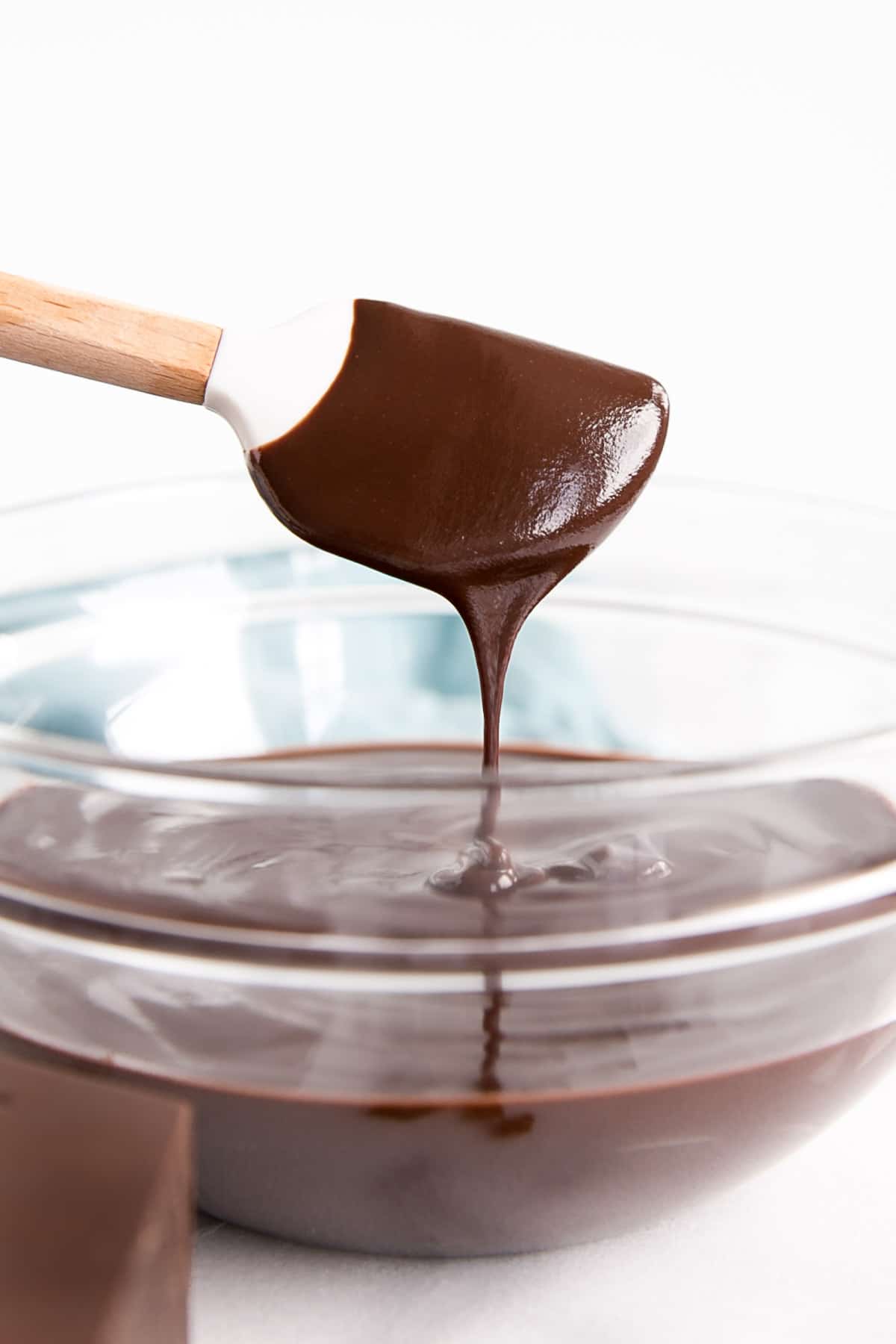
Ganache and I have a love/hate relationship.
As simple as it is to make, I have had my fair share of split and grainy ganache incidents. It’s usually due to me rushing or being impatient, but still. Making a ganache is an emulsion — similar to making mayonnaise — it’s precise, and it can split easily.
In my post today I’m going to talk about:
- What you need to make ganache
- Ratios for dark, milk, and white chocolate
- How to make it
- How to not screw it up
- How to save it if things go south
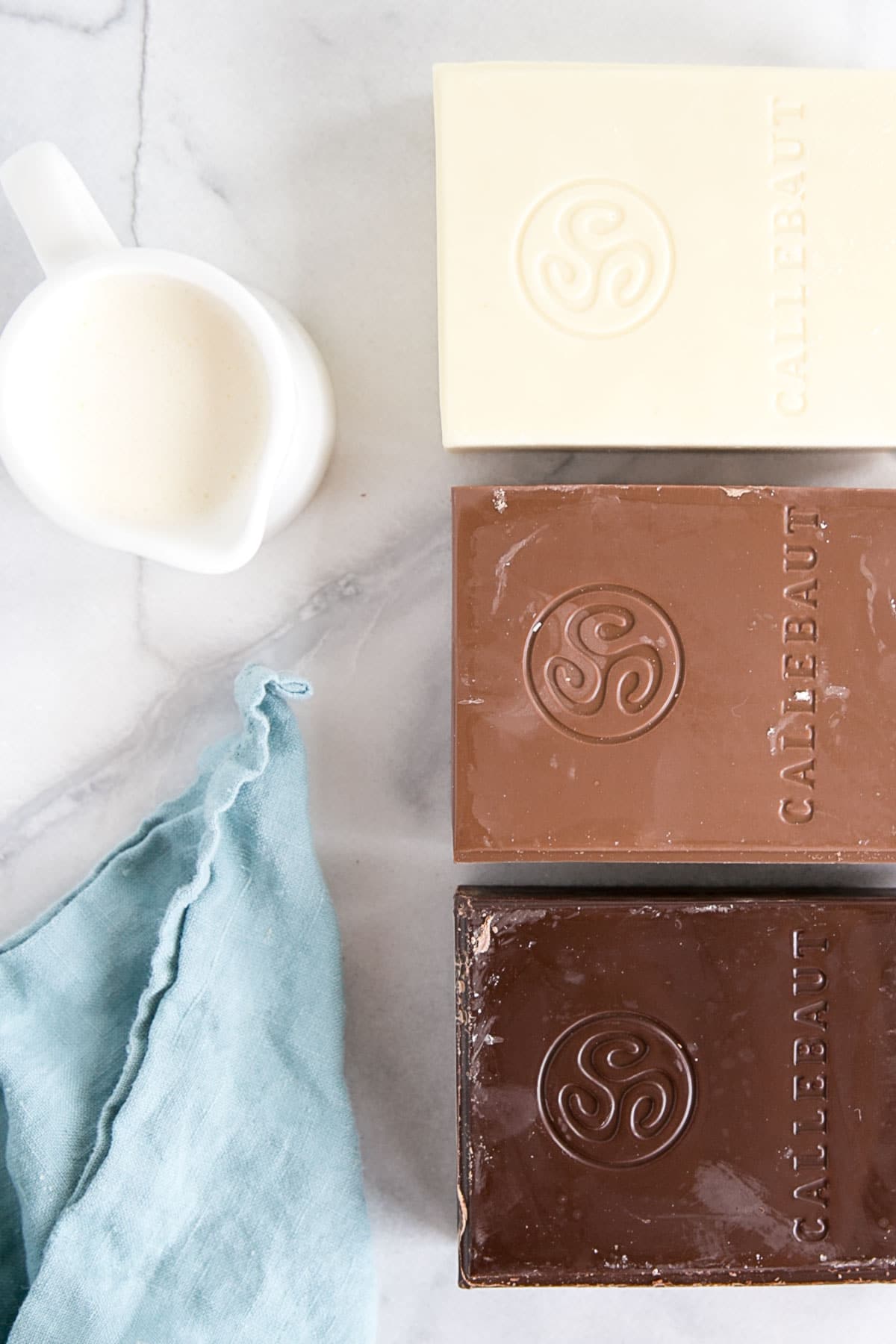
Chocolate Ganache Ingredients
Ganache consists of two simple ingredients — chocolate and cream.
It’s important to use the best quality chocolate you can find (couverture chocolate). These have a higher cocoa butter content and will help ensure your ganache is silky smooth. Using low-quality chocolate is not recommended (though I have done it successfully). It may not give you as nice a texture/consistency and could be more prone to splitting.
My favorite brand of chocolate to use is Callebaut, but it’s also the brand that’s easiest for me to get. Other examples of great high-quality chocolate brands are:
If these are hard to find (most are), you can also use Lindt or Ghiradelli, which should be readily available in your grocery store.
For the cream, use a heavy whipping cream (or double cream) with a high-fat percentage. This will help ensure your ganache is rich and delicious, but also stable.
Apparently, you can make ganache with just chocolate and water, but I haven’t tried it myself. This seems counter-intuitive to everything I know about how chocolate and water react together — water is notorious for causing chocolate to seize.
I highly recommend using cream instead, but if you’re in a bind you can try it with water. You will need to use less water than cream though, due to consistency.
Ganache Tip
Use the best quality chocolate you can get your hands on and a cream with a high fat percentage.
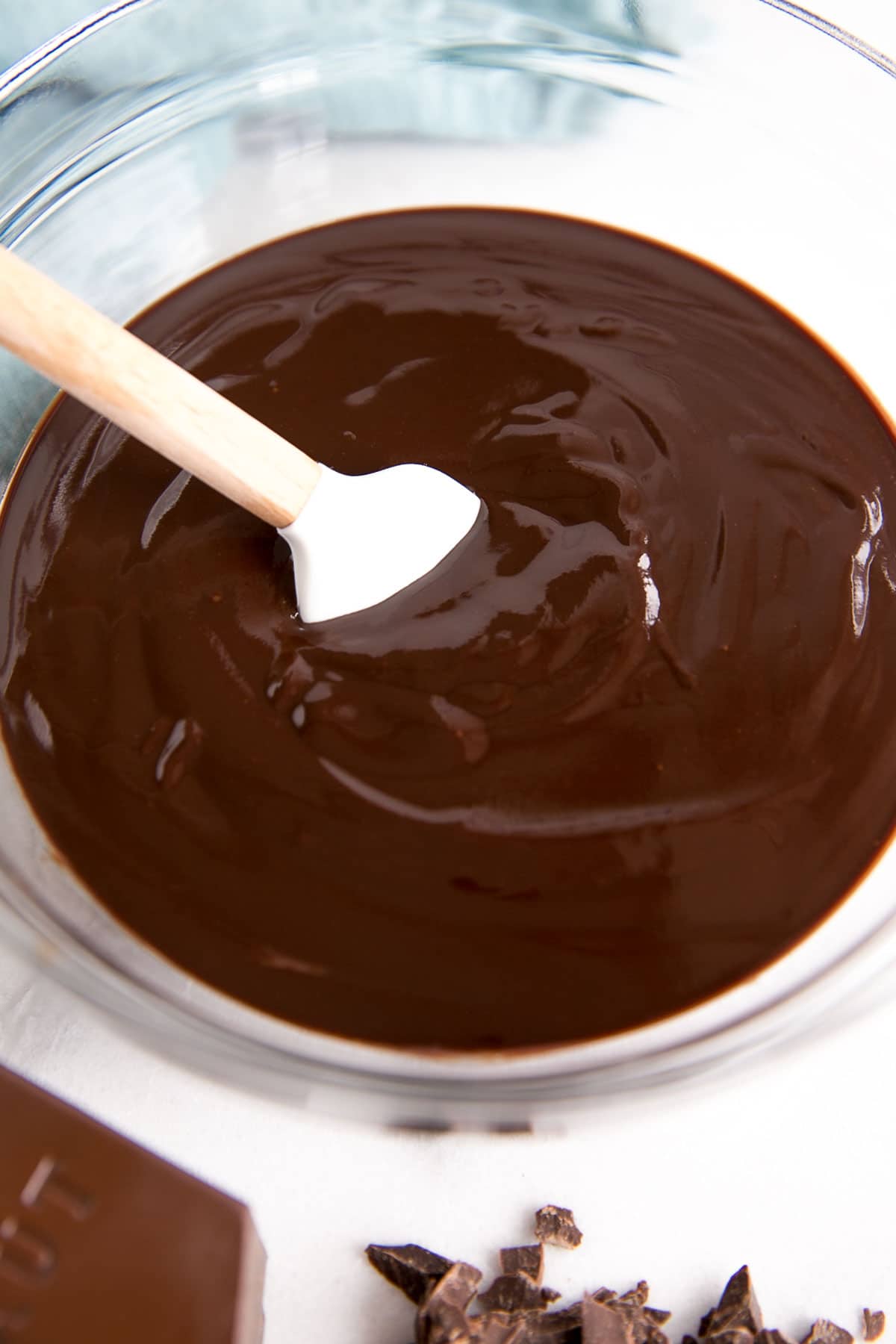
Chocolate to Cream Ratios
Ganache ratios are a bit of a personal preference kinda thing. I polled the members of my Baking Group on Facebook to see if there was a consensus (thanks for your input, everyone!), but the feedback was varied and everyone seems to do things a little differently.
There is no right or wrong.
I’m including the ratios that I like to use, and that work best for me. These should be a good starting point if you’ve never made it before.
We use ratios when making ganache so that you can customize it to whatever amount you need. When I say 2:1 chocolate to cream, that means two parts chocolate to one part cream — twice as much chocolate as cream. For example:
- 200 g chocolate to 100 g cream
- 2 oz chocolate to 1 oz cream
- 500 g chocolate to 250 g cream
- 11 oz chocolate to 5.5 oz cream
A 3:1 ratio (three parts chocolate to one part cream, or three times as much chocolate as cream) would look something like this:
- 200 g chocolate to 67 g cream
- 6 oz chocolate to 2 oz cream
- 500 g chocolate to 167 g cream
- 12oz chocolate to 4 oz cream
These are all just examples — you can customize the amounts to whatever volume of ganache you need.
You’ll notice I’ve listed all of the examples by weight rather than volume — 1 cup of chocolate chips and 1 cup of finely chopped chocolate will not be the same amount of chocolate, and will affect the consistency of your ganache.
As such, I highly recommend using weight instead of volume to measure your ingredients when making ganache.
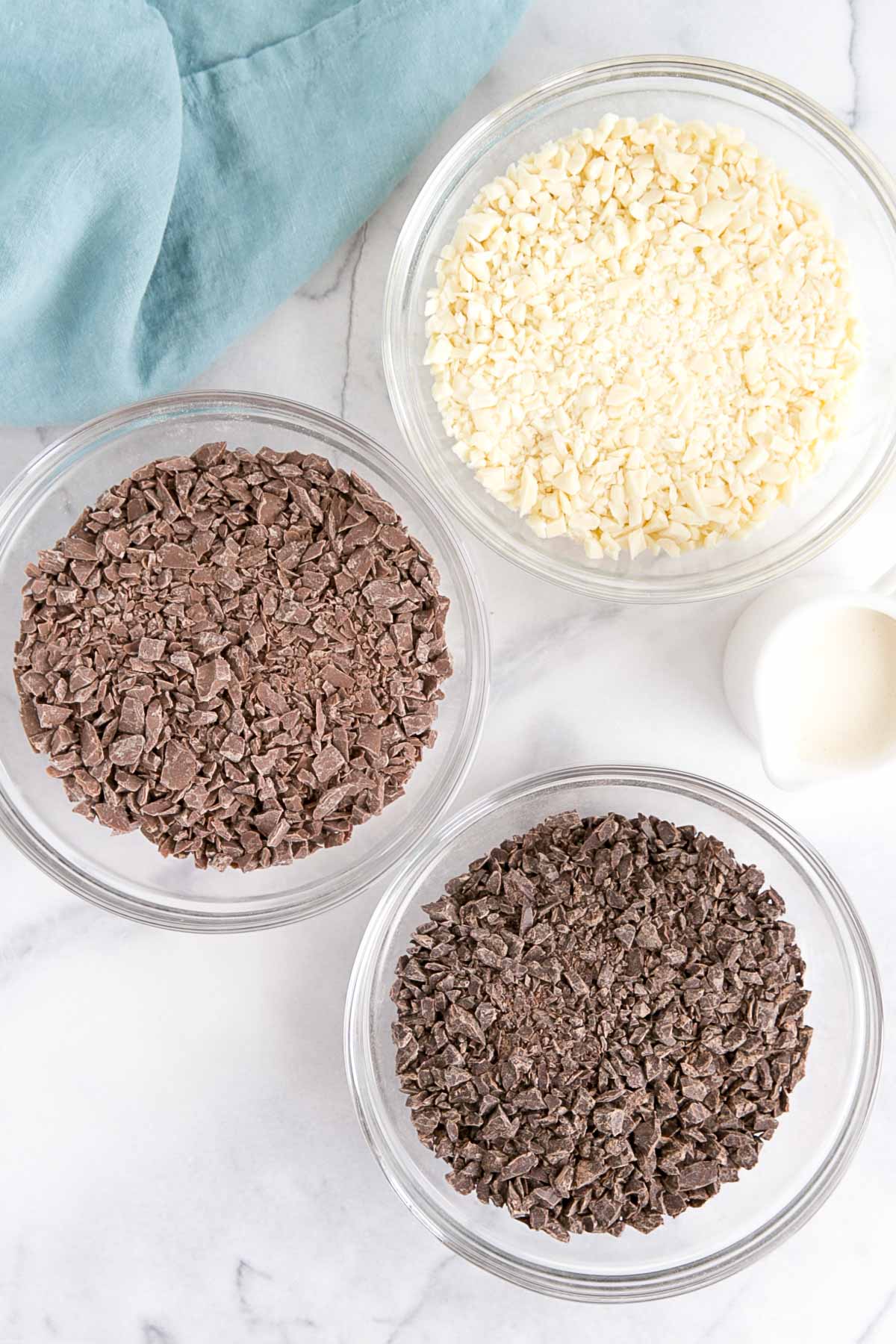
Dark vs Milk vs White Chocolate
The ratios will be different depending on the type of chocolate you are using – dark, milk, or white.
- Dark chocolate contains cocoa solids, cocoa butter, and sugar, but little or no milk solids.
- Milk chocolate contains cocoa solids, cocoa butter, and sugar, and has more milk solids than dark chocolate.
- White chocolate does not contain any cocoa solids and is made up of cocoa butter, sugar, and milk solids.
Since milk and white chocolate have more milk solids than dark chocolate does, they require less cream to get to the same consistency as dark chocolate ganache.
Here are the ratios I use for frostings, fillings, and drips.
Frosting/Firm Filling (chocolate : cream)
- Dark Chocolate – 2 : 1
- Milk Chocolate – 2.5 : 1
- White Chocolate – 3.5 : 1
Drip/Soft Filling/Whipped Ganache/Glaze (chocolate : cream)
- Dark Chocolate – 1 : 1
- Milk Chocolate – 2 : 1
- White Chocolate – 3 : 1
You may notice that some of my past recipes used different proportions and/or butter. It’s taken me a while to figure out the amounts that work well for me, and I’ve stopped using butter due to splitting issues. Read on for that.
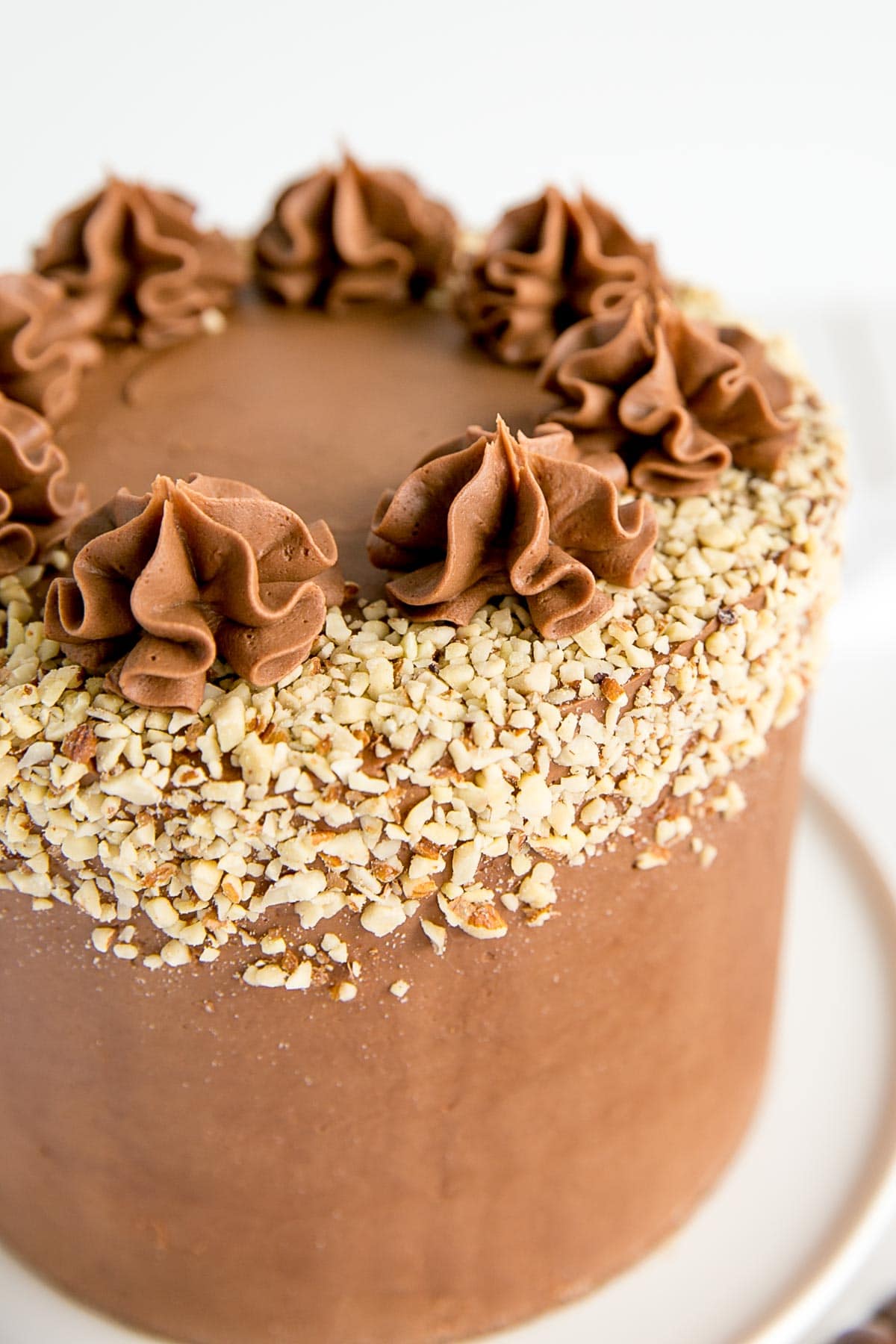
Whipped Chocolate Ganache
Whipping the ganache once it’s set it will lighten the color significantly, and it will make it almost a peanut butter consistency. In the Milk Chocolate Almond Cake above, I used whipped ganache for the outside and used unwhipped as a filling.
Ganache is most often used in its whipped form as a filling or frosting, but I prefer the darker color and smooth texture of unwhipped ganache. You can see that here in this Baileys & Guinness Cake and the Chocolate Truffle Cake below. It can be trickier to work with though, as it is a bit softer.
You can whip any kind of ganache — white, milk, or dark.
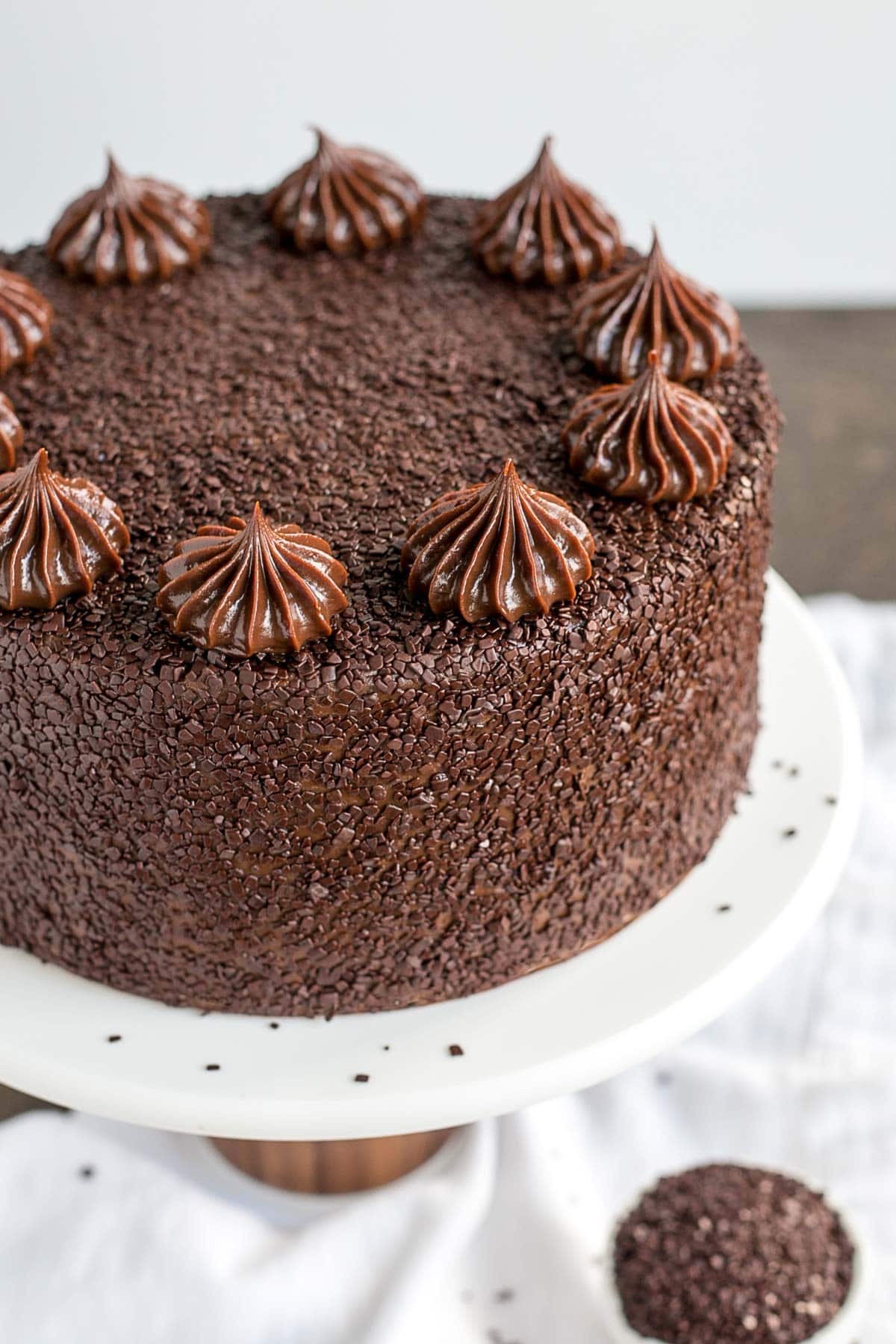
How to Make Chocolate Ganache
Now that you have a good overview of what ganache is and how it works, let’s get into the process.
There are a couple of ways you can make ganache — the hot cream method and the microwave method. I’m going to walk you through the hot cream process step-by-step and talk about the microwave method below.
Step #1 – Chop your chocolate – Finely chop your chocolate and place it in a metal or glass bowl. You should actually chop it finer than in the picture below. Mine still had some larger chunks in it.
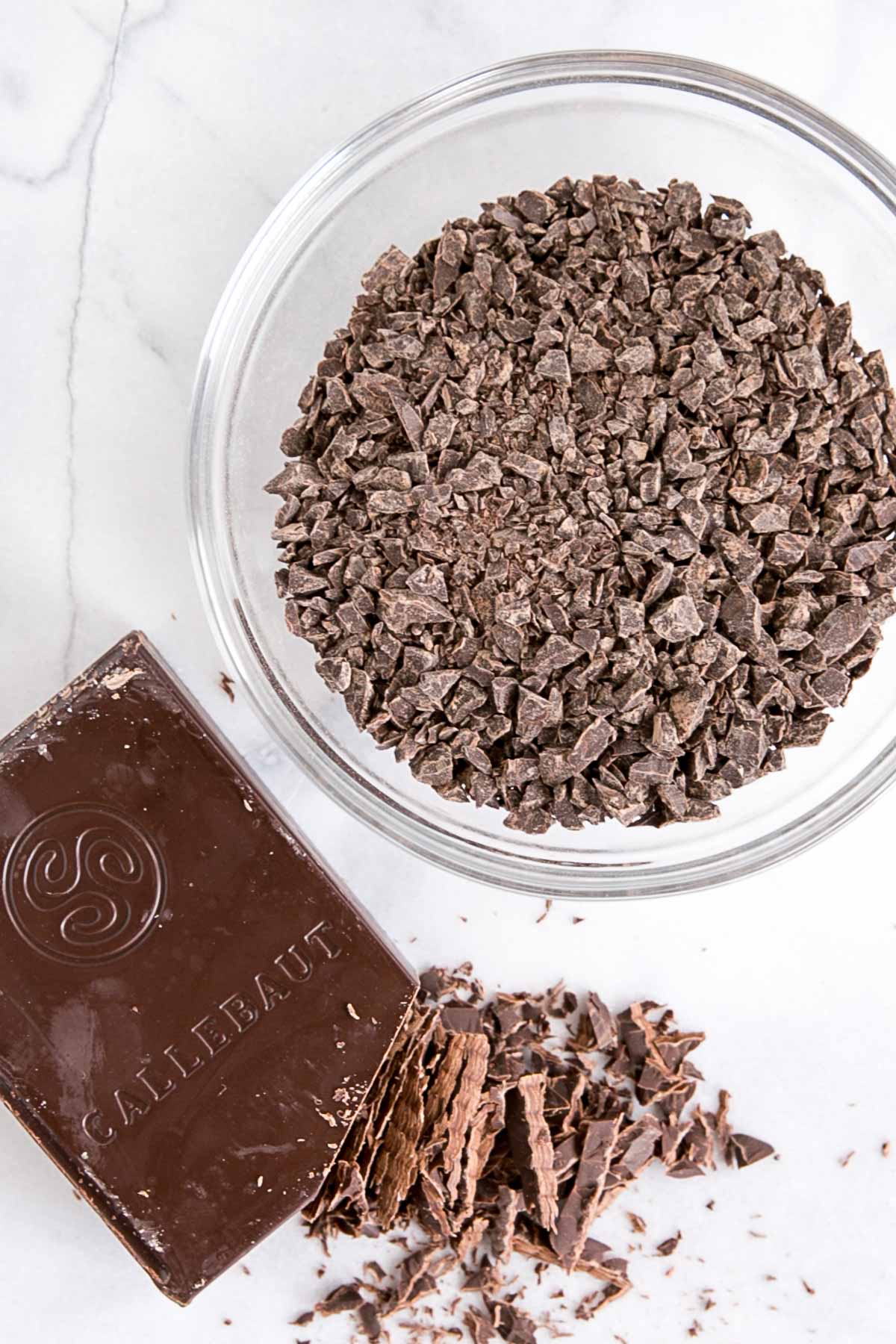
Step #2 – Heat your cream – Bring your cream just barely to a simmer. You don’t want it too hot and you do NOT want it to boil. You should just start to see bubbles or ripples around the edges of the pot. This process is called scalding.
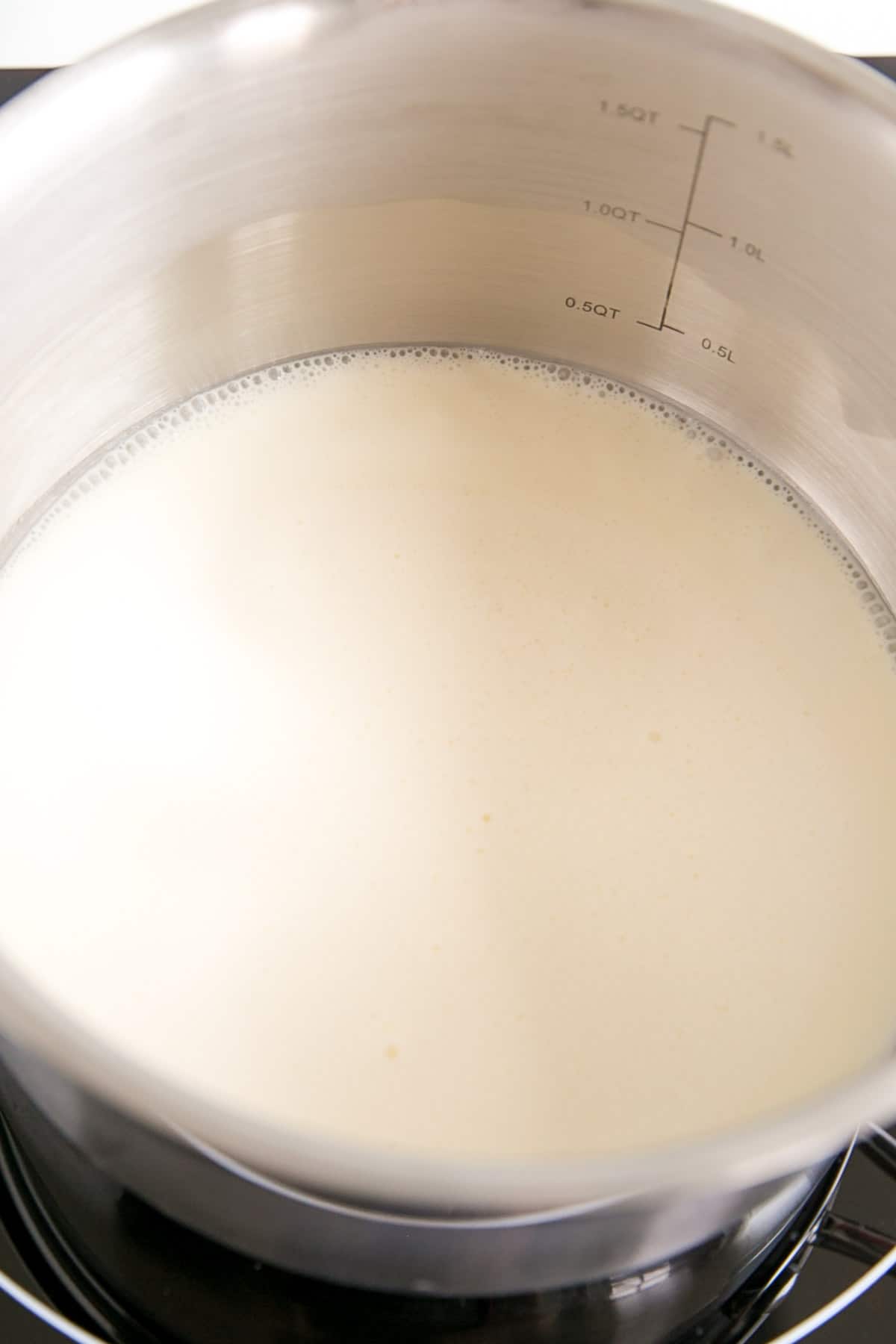
Step #3 – Pour cream over chocolate – Pour your hot cream directly and evenly over your chopped chocolate.
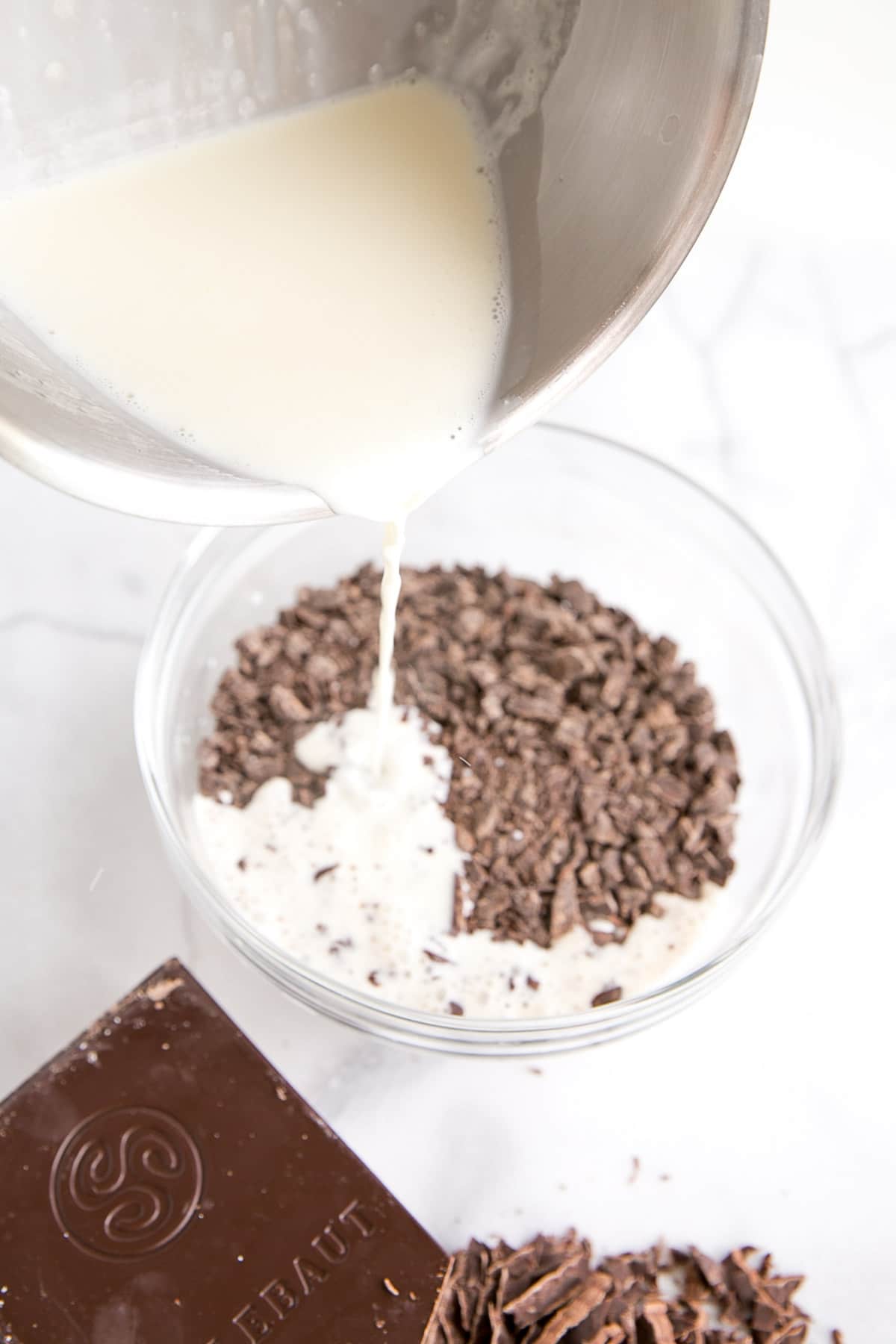
Step #4 – Cover & Rest – Cover the whole bowl with plastic wrap and let sit for 2 minutes. The plastic wrap helps trap the heat.
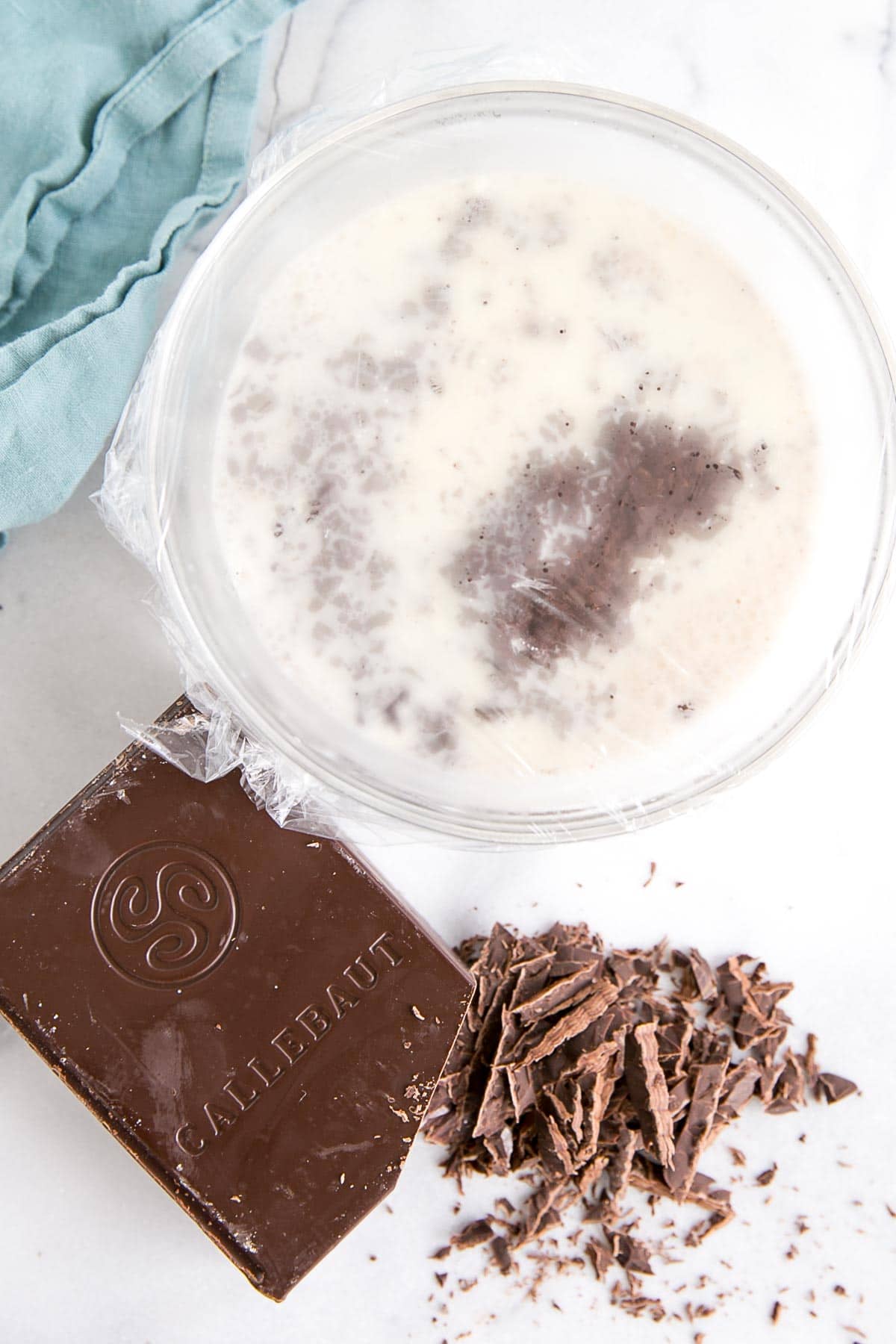
Step #5 – Stir to combine – Using a spatula, begin to stir the ganache from the center, slowly working your way outwards. Do not stir too quickly or vigorously.
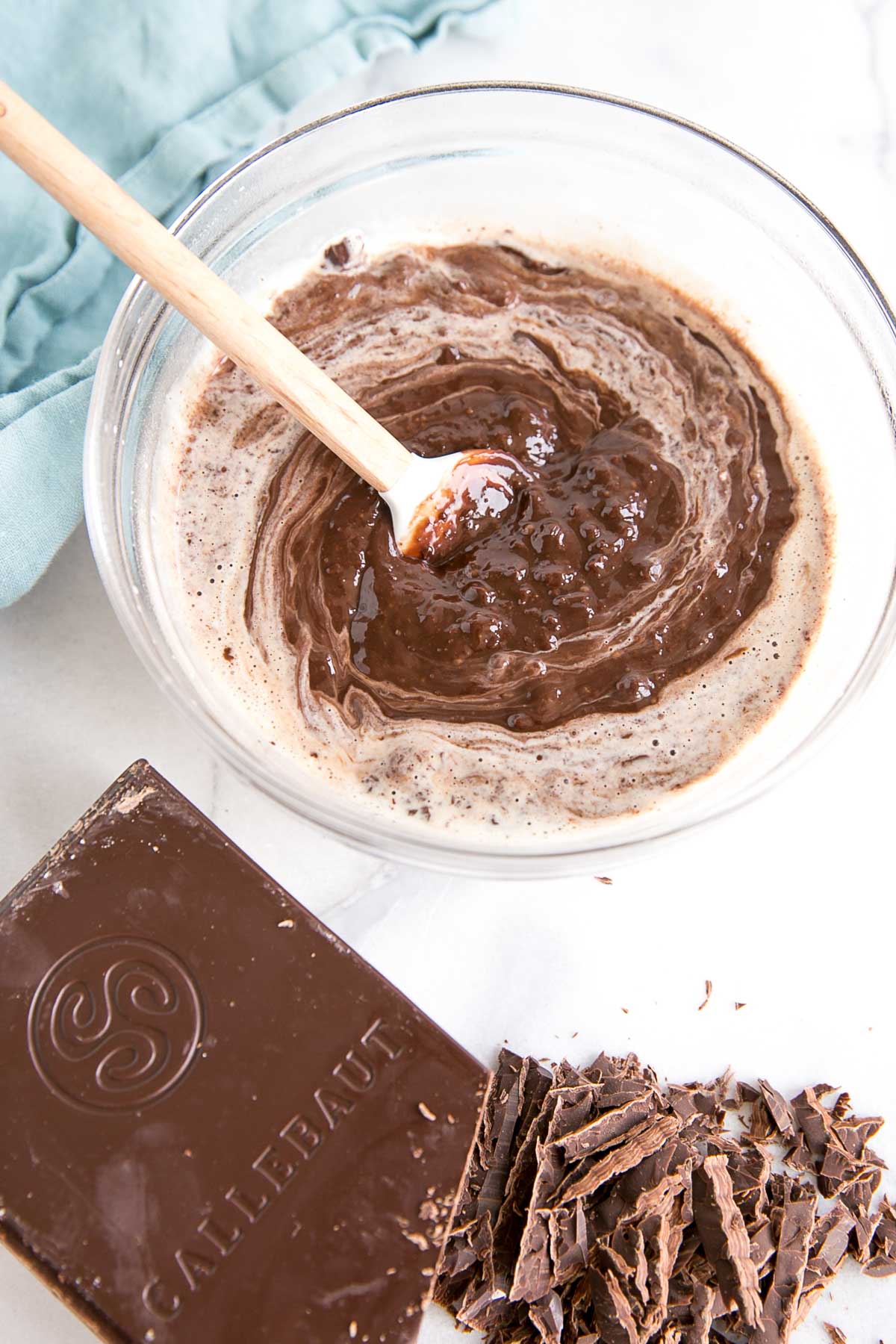
Take your time until everything is combined and completely smooth.
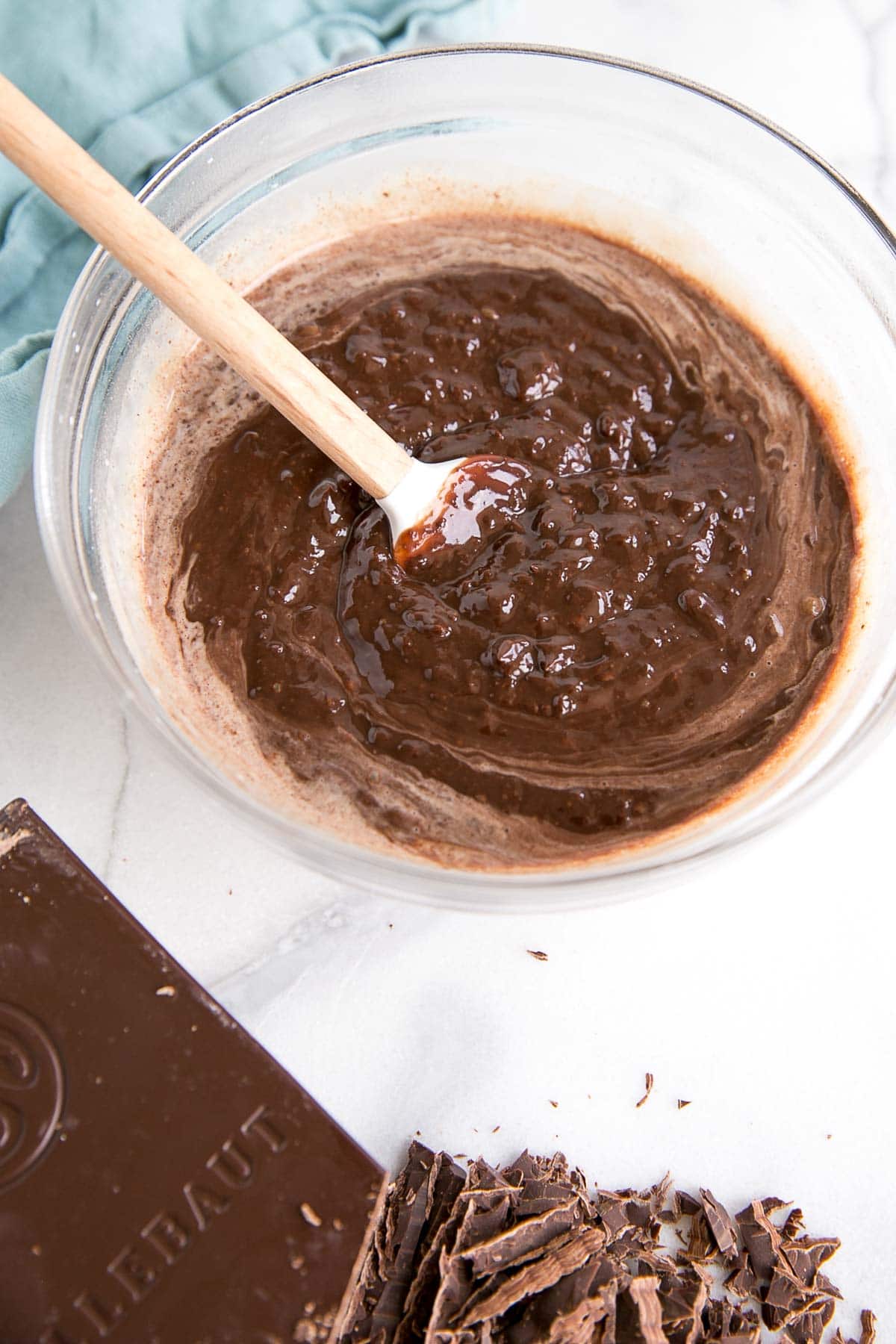
Keep stirring until it’s silky smooth.
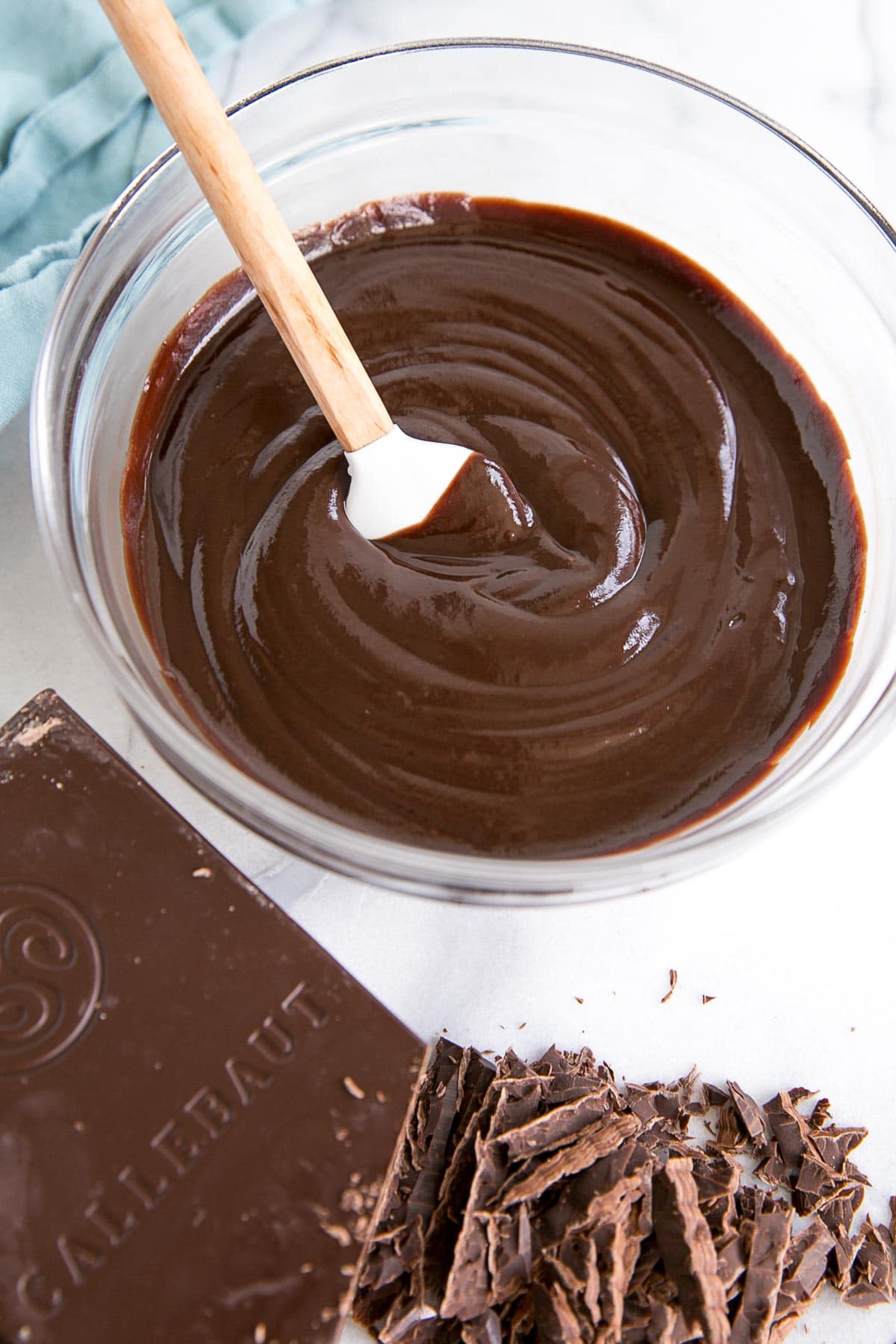
If at this point you find that you still have some larger chunks that haven’t dissolved, you can place the whole bowl over a pot with 1-2″ of simmering water and stir until completely smooth.
Step #6 – Cover and set – Place plastic wrap directly on the surface to prevent a skin from forming and let sit until cooled, thickened, and set.
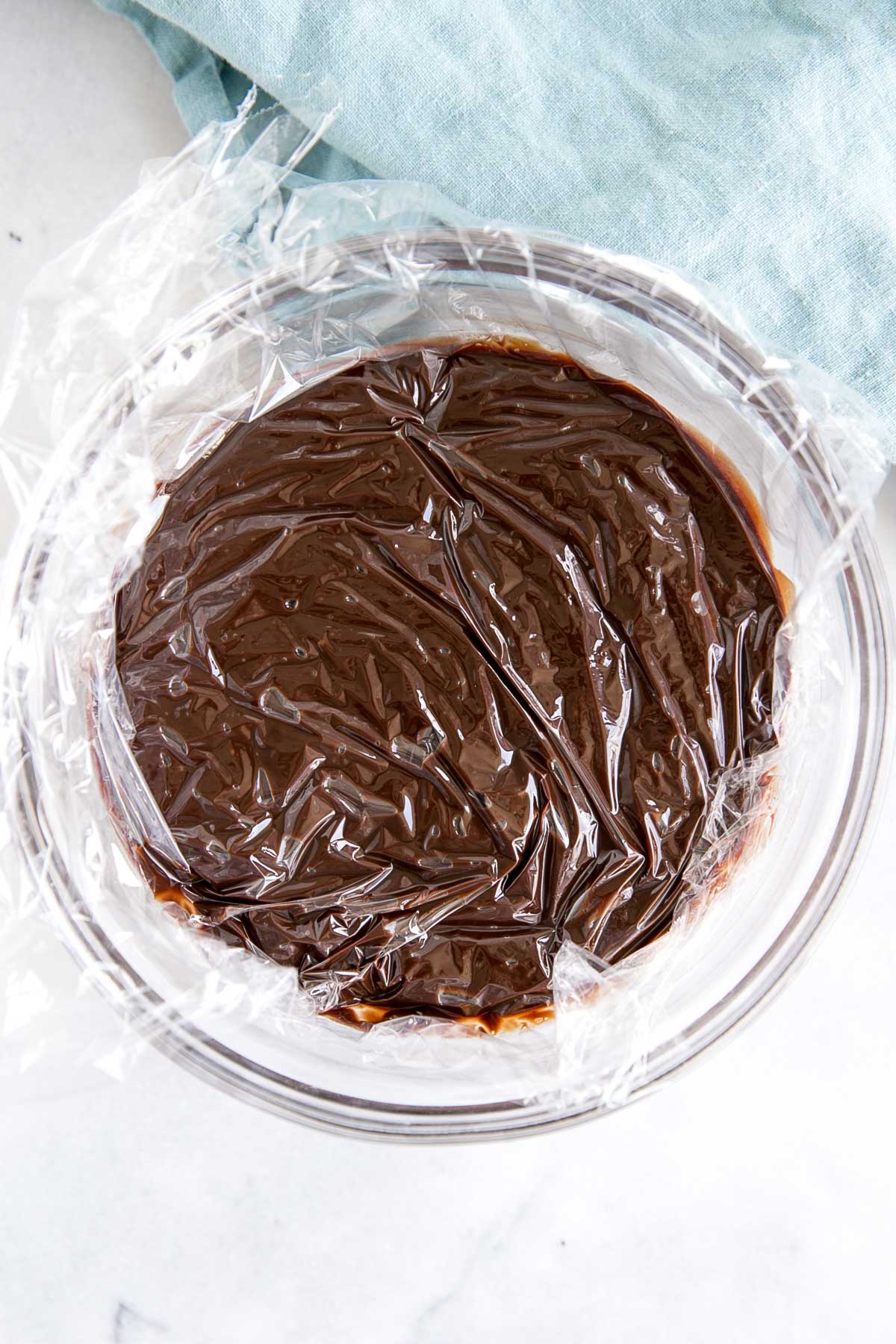
My ganache actually ended up splitting. Read on to find out why and how to fix it.
Microwave Ganache
The microwave method seems simple, but it can cause your chocolate to heat too much too quickly. For this method you heat your chopped chocolate and cream at the same time in a microwave-safe bowl.
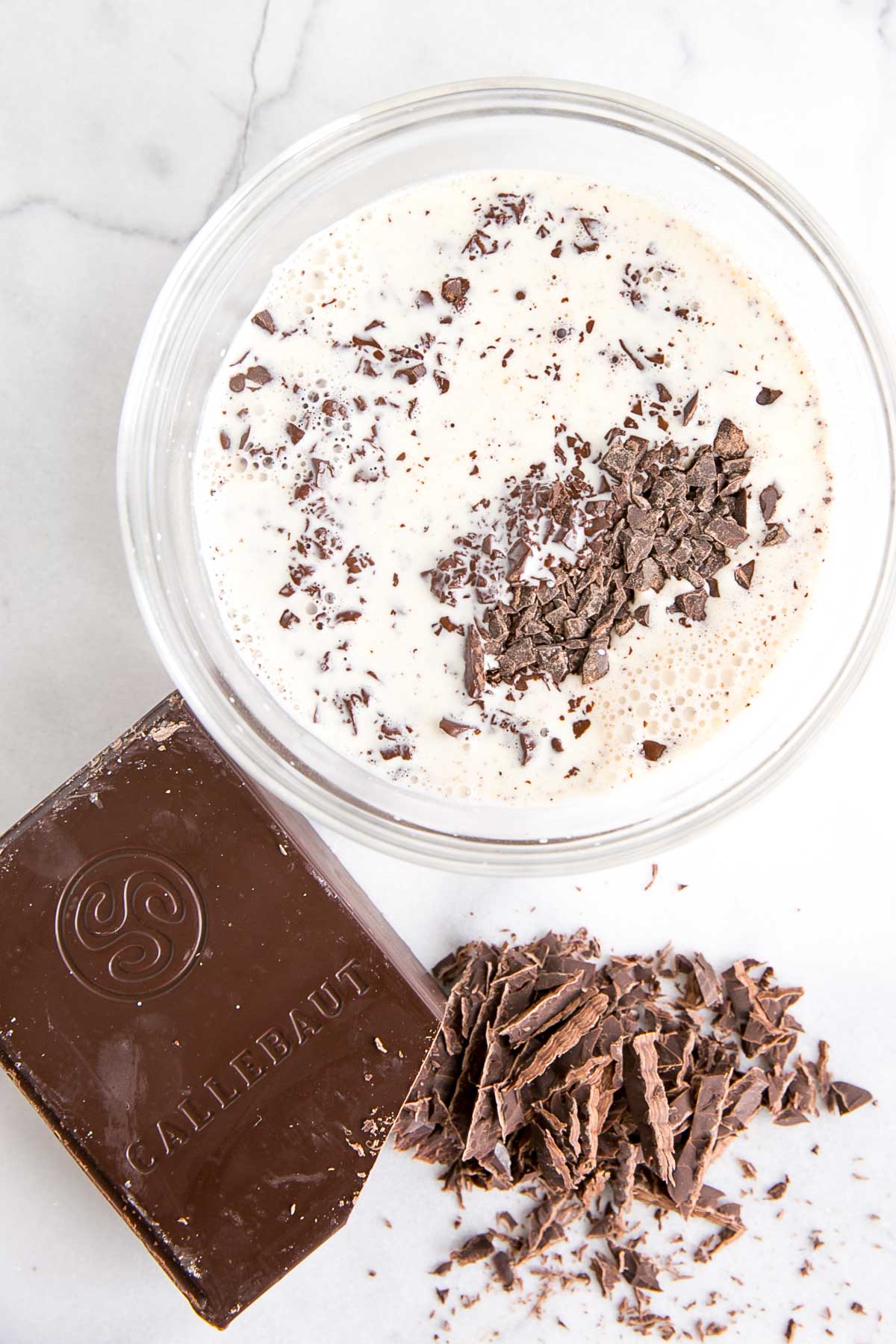
Steps for making ganache in the microwave:
- Place chopped chocolate and cream into a glass (not plastic) bowl
- Heat for 20 seconds, then stir
- Heat in 10 second increments, stirring in between, until the ganache is completely smooth
I don’t use this method often, because I find that it requires more “hands-on” time than the hot cream method. It’s also easy to accidentally overdo it and overheat your chocolate and cream, which can cause it to seize or split.
How to Fix Split Ganache
Ganache is an emulsion and it’s very easy to cause that emulsion to break, resulting in a grainy and/or oily ganache.
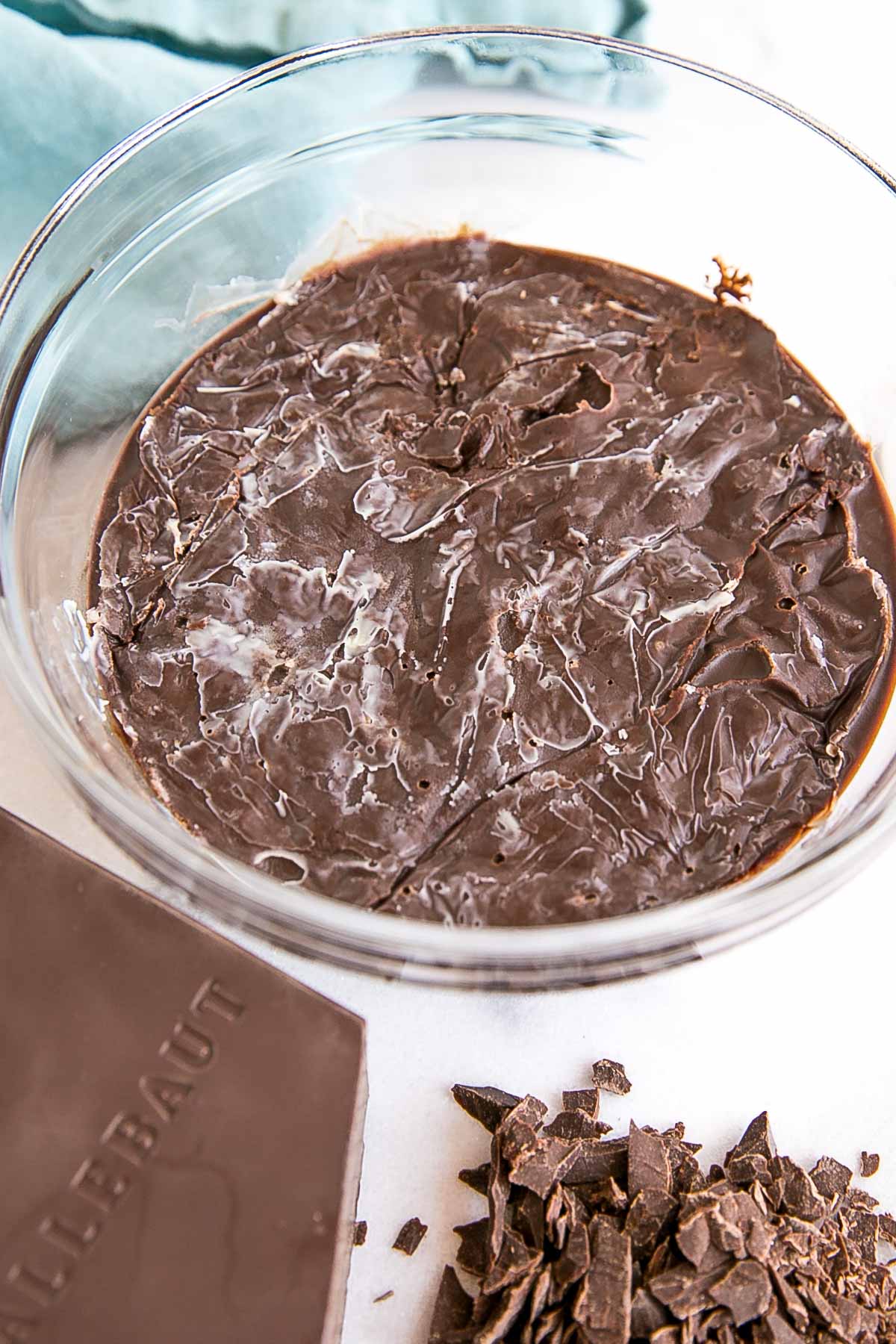
Why Ganache Splits:
- Your cream was too hot
- You started stirring before the chocolate had enough time to melt
- You stirred too vigorously
- You kept stirring it once it was smooth and emulsified
- There was too much fat in it (butter usually causes this)
How to fix Split Ganache:
- Warm the ganache over a pot with 1-2″ of simmering water and whisk vigorously until smooth.
- If your ganache hasn’t set yet and is still warm, add a couple of teaspoons of warm milk to it while whisking quickly. Note that this will thin your ganache out though, depending on how much milk you end up using.
- Use an immersion blender with either of the two methods above to help ensure emulsification.
I’ll be honest here, I’m an expert at breaking ganache, but not an expert at fixing it. I’ve only had partial success.
Mine actually split so bad there were actually chunks (of what I assume is cocoa butter) in it this time. This is not unmelted chocolate, the ganache was completely smooth before it set.
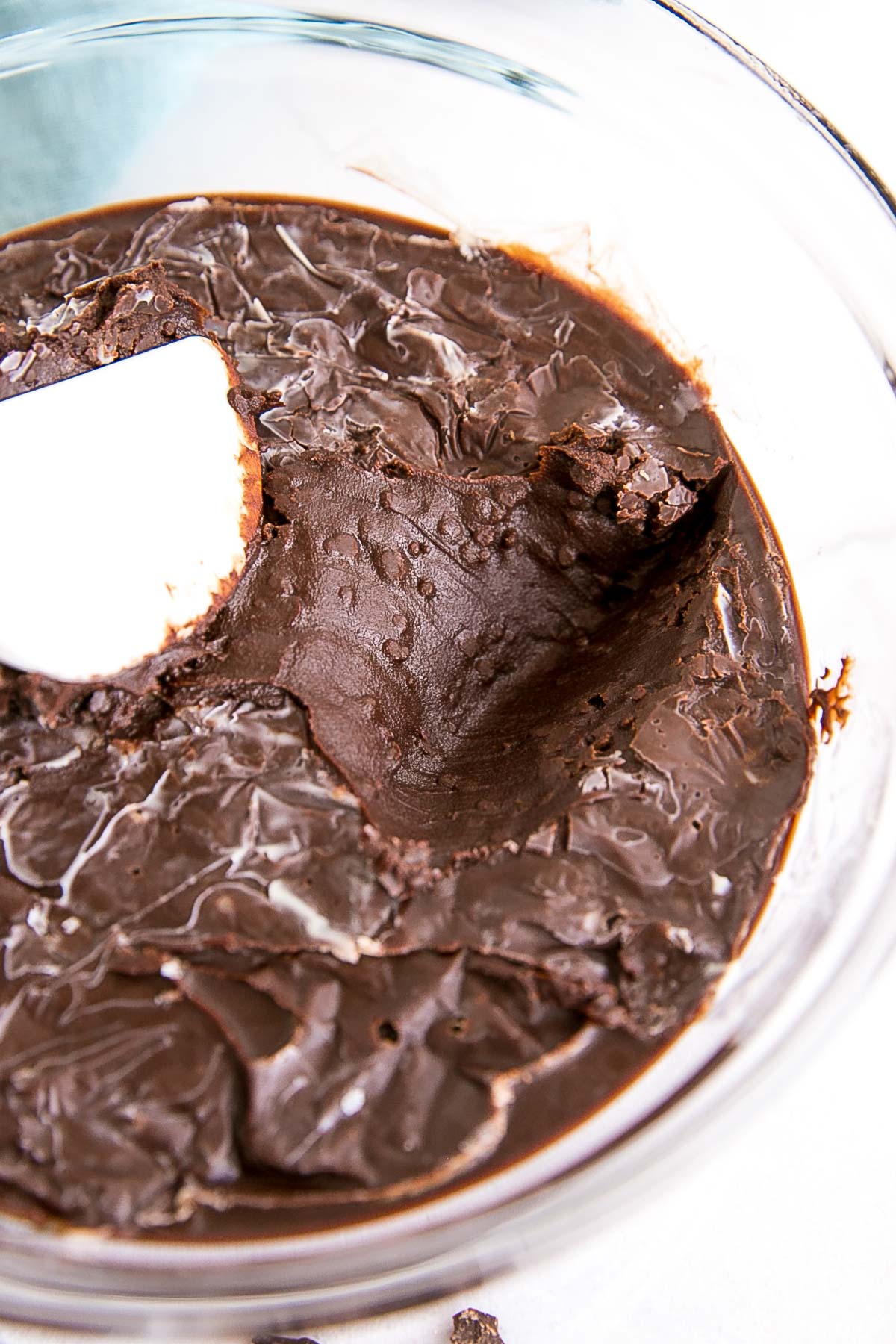
I warmed the whole thing over a pot of simmering water to smooth it out again.
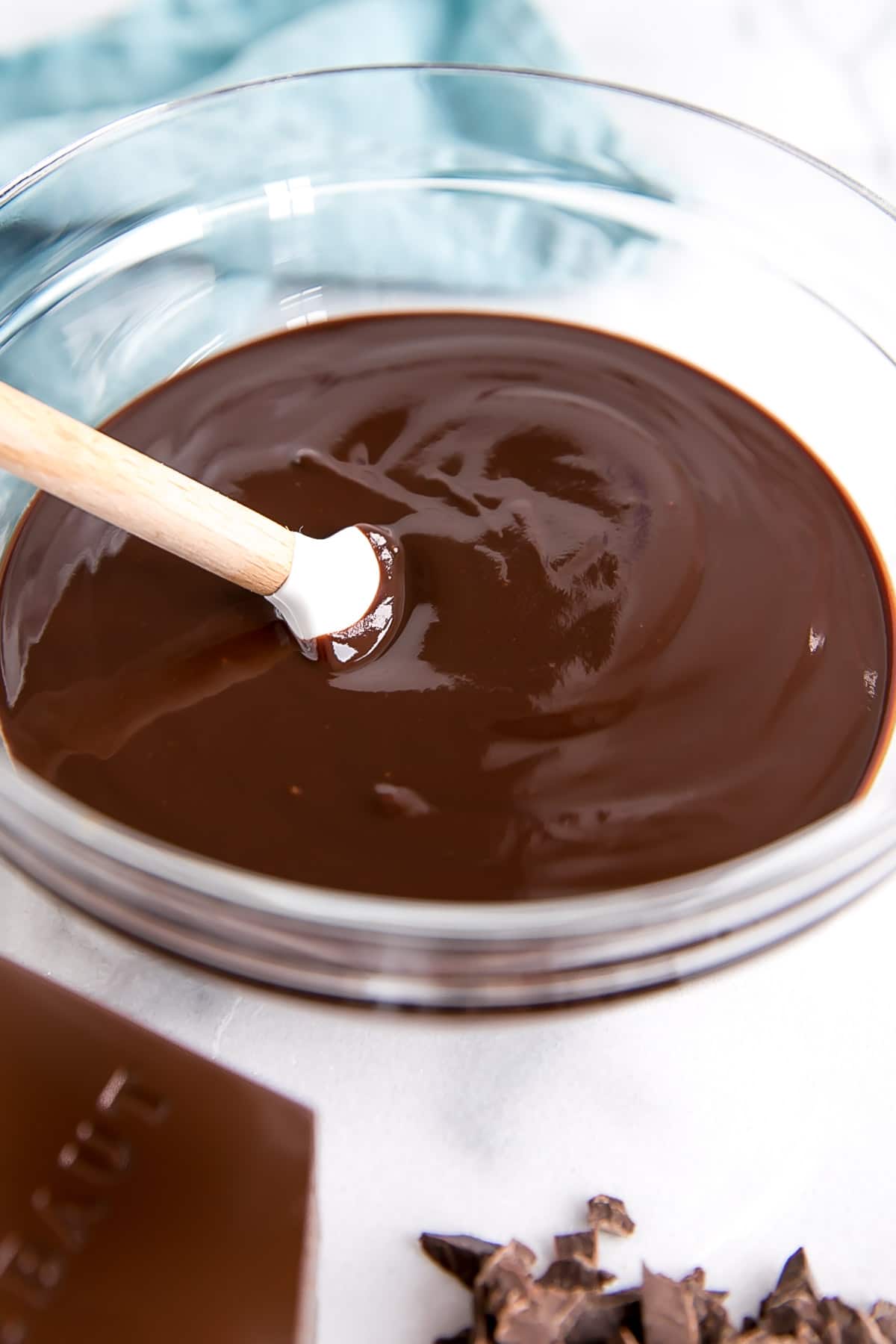
There are a number of reasons mine could have split this time…
It’s likely the cream was too hot, since it did boil as I was taking pics. I let it sit and cool for a bit before pouring it over the chopped chocolate, but maybe it didn’t cool enough.
I kept stirring it once it was smooth and set because I was trying to take pics of it drizzling off the spatula. The extra agitation while it was cooling could have caused it to split.
I also should have chopped the chocolate more so it was smaller chunks.
The milk and white chocolate turned out completely fine, but I made those at a separate time (when I was not distracted by photos), covered them, and left them alone.
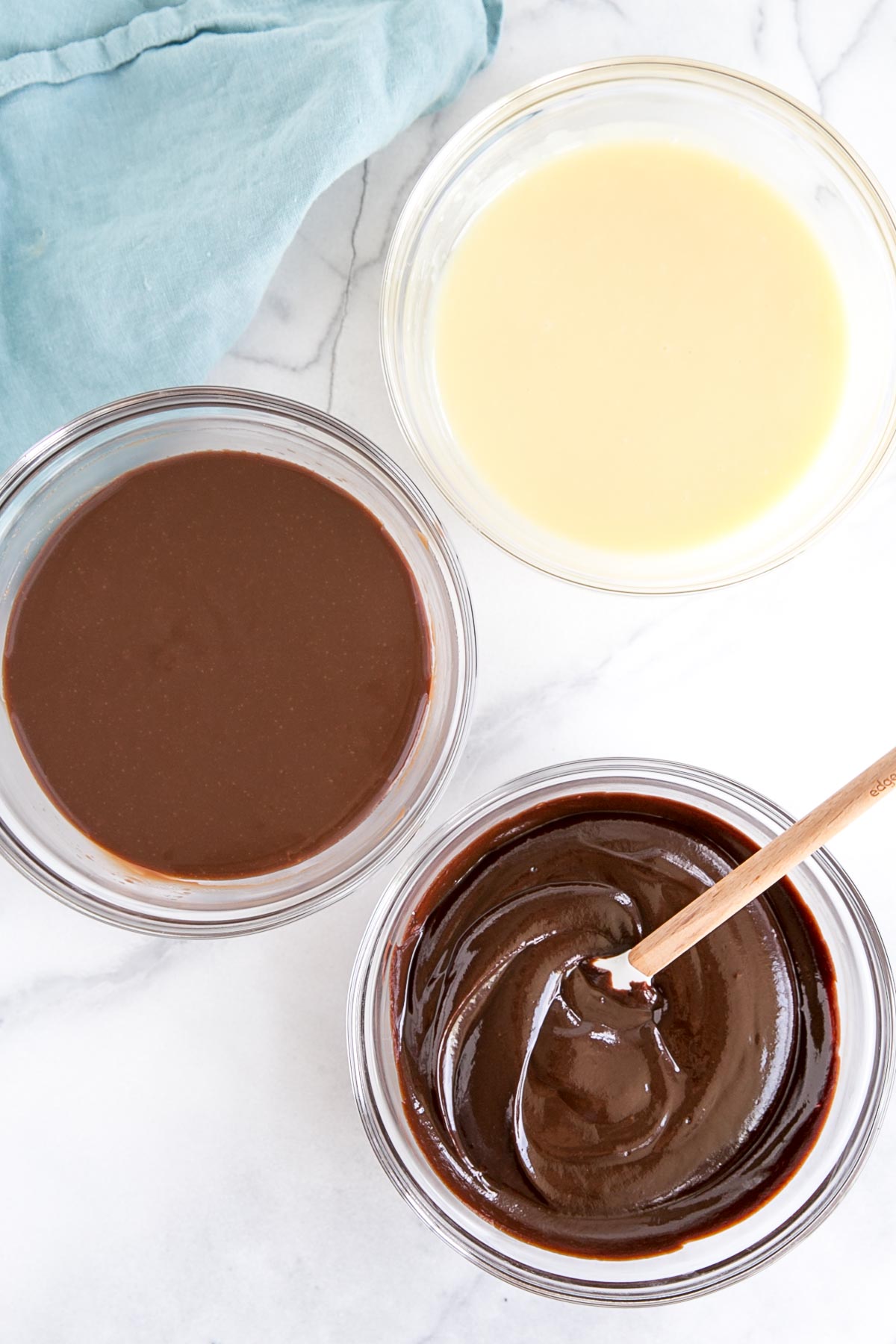
Do’s and Don’ts to Making Ganache
- Do use high quality (couverture) chocolate. This will make a huge difference in the taste and texture, and help ensure your ganache cooperates and doesn’t split.
- Do chop the chocolate as fine as possible. Larger chunks will take longer to melt into the cream and might not melt and emulsify fully, causing the ganache to split.
- Do use a glass or metal bowl. Plastic bowls can affect the texture and appearance.
- Use a glass bowl if making it in the microwave.
- Use a metal bowl if you’re doing the hot cream method — if you have some undissolved chunks you can place the bowl over a pot with 1-2″ of simmering water to help heat the ganache and melt the chocolate. You can do this with a glass bowl too, but it doesn’t conduct heat as well as metal.
- Do use cream with a high fat content. Heavy whipping cream (or double cream) for best results.
- Do use an immersion blender. To help the mixture emulsify.
- Don’t boil the cream. If it boils, let it stand for a few minutes to cool down a bit. If the cream is too hot it will cause the cocoa butter to separate from the chocolate and result in a split ganache.
- Don’t let your chocolate get too hot. Especially when using the microwave method.
- Don’t use a whisk to stir. A whisk can incorporate too much air, resulting in bubbles.
- Don’t stir too vigorously. Stir gently from the center working your way out until the ganache is shiny and smooth.
- Don’t stir or agitate the ganache when it’s cooling/setting. This can also cause it to split.
- Don’t refrigerate the ganache before you need to use it. This will cause it to set too firm and you’ll need to heat it up again.
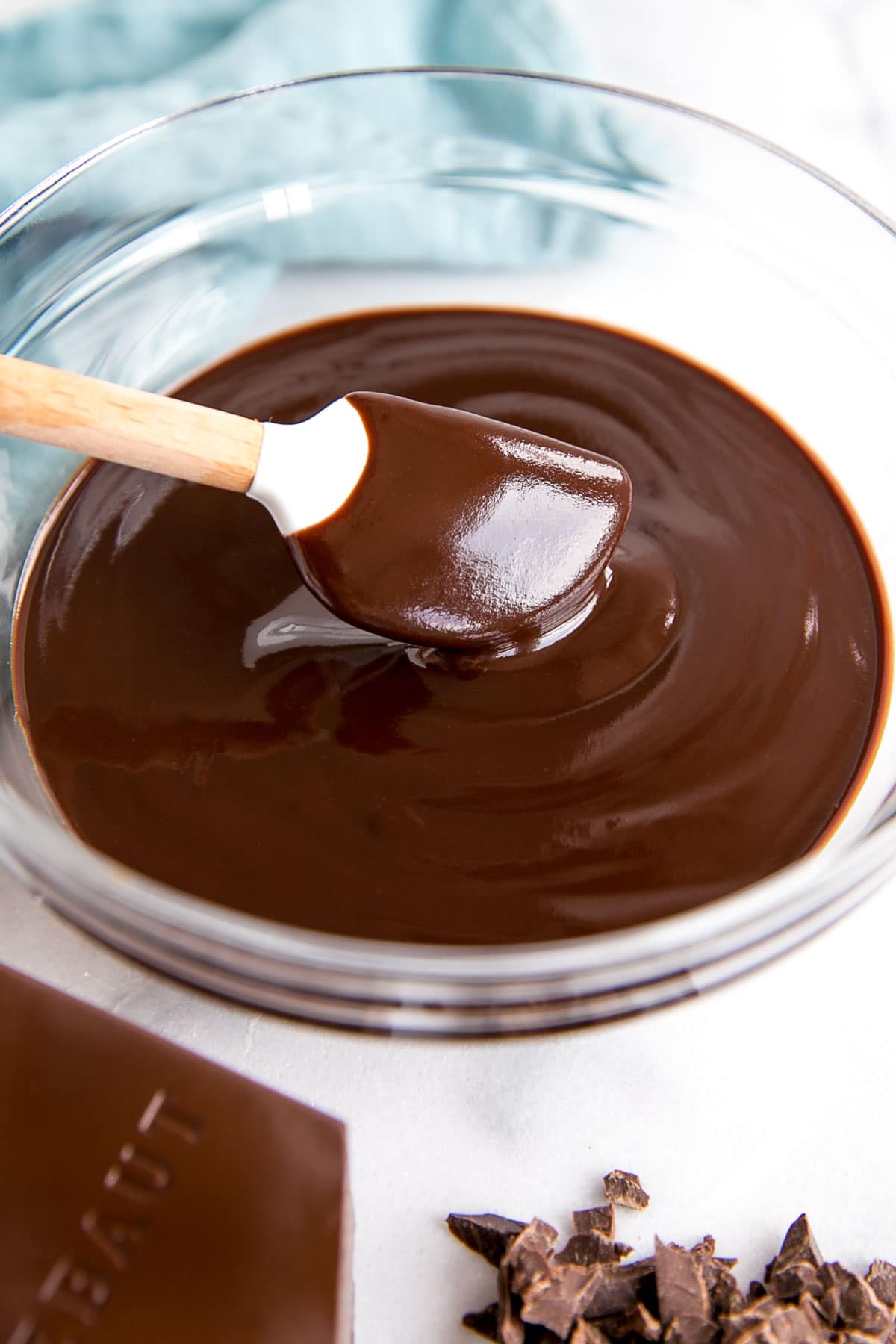
Frequently Asked Questions
You can add color to your white chocolate ganache at the end once it’s smooth. I recommend using gel or powdered colors rather than liquid for best results.
You can add flavor to the ganache in a couple of ways. You can infuse the cream with herbs, tea leaves, or other flavors. Add these before you heat the cream, then strain before pouring over the chocolate. Or you can add flavoring, extract, liqueur, or emulsions at the end once it’s smooth.
If your ganache is too soft when it is set too much cream was used or not enough chocolate.
If your ganache is too firm when it is set too much chocolate was used or not enough cream.
Ganache is fine at room temperature for two days, in the fridge for two weeks, or frozen for 3+ months. When storing it, be sure to cover and seal it so it’s air-tight. Ganache gets very firm in the fridge. If you intend to use it to frost a cake you must bring it to room temperature again.
Most of my older ganache recipes included butter. I used to add this for shine, but I think this was actually a big culprit in causing my ganache to split (too much fat). I do not recommend it and have since stopped using it. All you need is chocolate and cream!
I hope you found this post thorough and helpful. If you have any tips of your own on how you make (or save) ganache, I’d love to hear them in the comments!
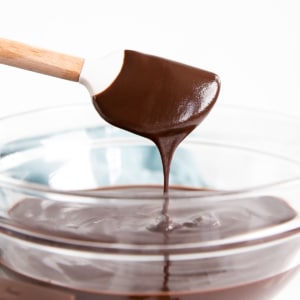
Chocolate Ganache
Ingredients
Firm Filling/Frosting – Dark Chocolate Ganache
- 600 g dark chocolate finely chopped
- 300 g heavy whipping cream or double cream
Firm Filling/Frosting – Milk Chocolate Ganache
- 650 g milk chocolate
- 260 g heavy whipping cream
Firm Filling/Frosting – White Chocolate Ganache
- 700 g white chocolate
- 200 g heavy whipping cream
Drip/Soft Filling/Whipped Ganache/Glaze – Dark Chocolate Ganache*
- 2 oz dark chocolate finely chopped
- 2 oz heavy whipping cream or double cream
Drip/Soft Filling/Whipped Ganache/Glaze – Milk Chocolate Ganache*
- 3 oz milk chocolate
- 1.5 oz heavy whipping cream
Drip/Soft Filling/Whipped Ganache/Glaze – White Chocolate Ganache*
- 3 oz white chocolate
- 1 oz heavy whipping cream
Instructions
Chocolate Ganache:
- Place finely chopped chocolate into a glass or metal bowl.
- Scald the cream by bringing it just barely to a simmer. Pour over chopped chocolate.
- Cover bowl with plastic wrap and let stand 2 mins. Stir gently with a spatula until combined and smooth.
- Place plastic wrap directly on the surface of the ganache. Allow to cool and thicken before using. Do not refrigerate.
Firm Filling/Frosting:
- Let ganache firm up overnight at room temperature. Use as is as as a filling and/or frosting.
Drip/Soft Filling/Whipped Ganache/Glaze:
- Allow ganache to cool completely and thicken slightly before using as a drip. I let mine cool and thicken overnight, then warm it in the microwave for 3-5 seconds before using.* Note that the amounts shown are enough to make a drip. You will need to increase the amounts to make a filling, whipped ganache, or glaze.
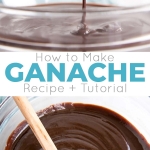

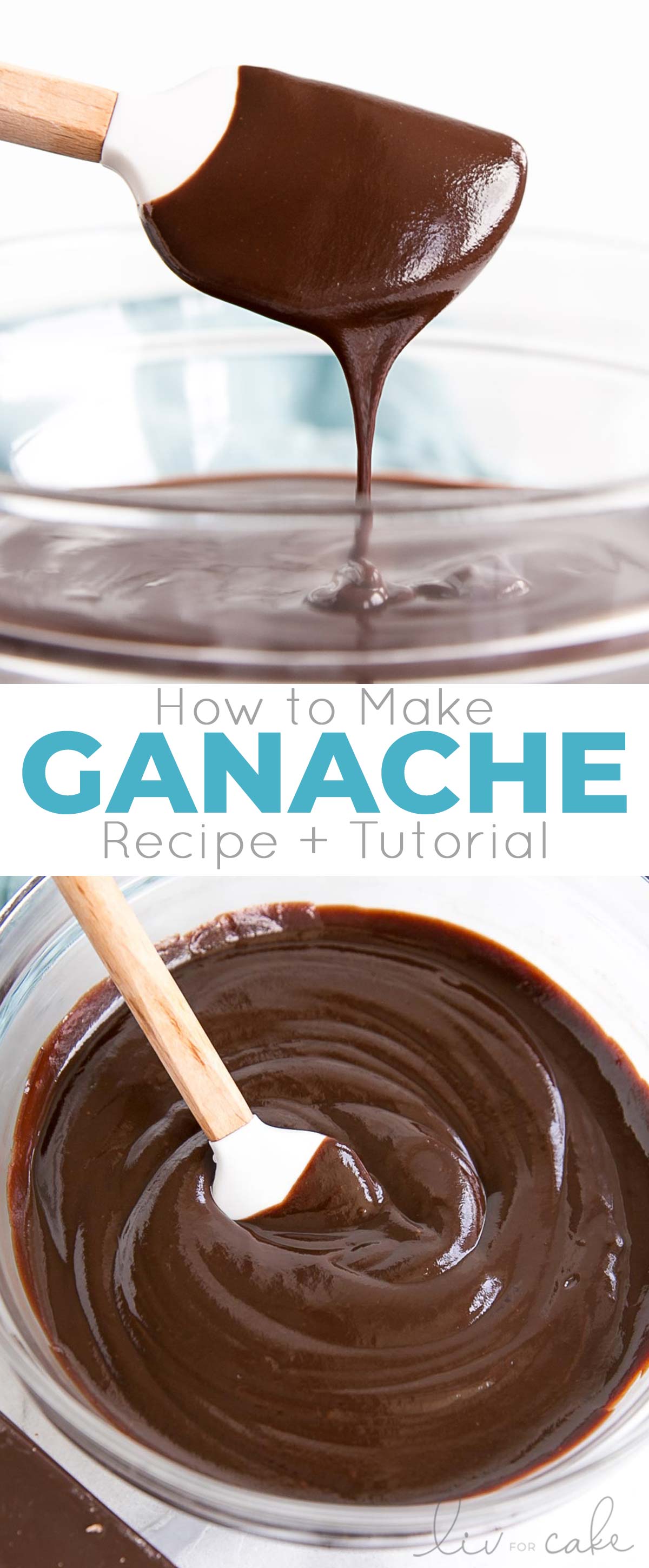
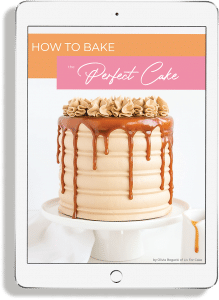









CT says
Hi Olivia,
Thank you for your guidance and lots of information on ganache.
May I ask about callebaut chocolate.
Does dark chocolate no.811, milk chocolate no.823, white chocolate no.w2 and Ruby chocolate RB1, are they suitable to use as chocolate to make ganache.
If yes… May I use the ratio above as guidelines to make the ganache. And what ratio do I use if I need a no so sweet ganache.
Thank you so much for sharing.
Olivia says
Hi CT! All of those would be perfectly fine for ganache. Any Callebaut is wonderful. Use the above ratios for the dark/milk/white. As for the ruby, I’ve never used that one before. Looking at the composition I would use the milk chocolate ratios for that one. The darker the chocolate usually the less sweet it is. You can use a high percentage dark chocolate for the ganache using the dark chocolate ratios and it will be great. Let me know how they all turn out 🙂
CT says
Hi Olivia,
Thank you for your advice. I will definitely try it out and let you know. I have plan to bake a cake for a coming up birthday and it is now summer in UK, is it ok for me to choose chocolate ganache to frost the cake. This is my first time using ganache and I hope it won’t melt away at room temperature.
Thank you
Olivia says
Ganache is the best type of frosting you can use in higher temperatures. It holds up much better than buttercream!
CT says
Thank you Olivia, I will give it a trial tomorrow and let you know the outcome.
mary samaniego says
Thank You for answering my question so quickly, to tell you the truth, I never expected an answer, other sites never answer me back. I am so very happy I found your site. I’m hooked!! I have one more question for you. After I make the white chocolate ganache, I suppose to let it set for awhile until it sets up harder. I want to cover my cake with it before I cover my cakes in fondant. Do I reheat the ganache to make it spreadable? And will it set up on the cake so I can cover it with fondant. I never used ganache for covering a cake before,( I guess you can tell). After I cover the cake, can I put it in the fridge before I cover it with fondant and can I put it in the fridge after I cover it with fondant? Thanks for your help, I appreciate you.
Olivia says
Hi Mary! I always try to answer all comments and questions here. I’m glad you found me! 😀 For covering the cake I would do a whipped ganache. Do the 3:1 ratio of white chocolate, let that cool completely and set a bit and then whip it. Whipping will help firm it up some more too so it’s spreadable. It should be the consistency of peanut butter. I like to use a hot bench scraper to smooth it out nicely. It works great under fondant as it sets very firm on the cake. Frodge before covering with fondant is totally fine and will help it set. Fridge after fondant I’m not sure as it’s been a long time since I’ve worked with it. I never had issues but you can have problems with condensation.
mary diane samaniego says
Hello, I am trying to figure out when is white chocolate to be tempered. I have Guittard 30% white wafers. Do I have to temper them before I make ganache? If I do, what temperature does the chocolate need to reach to be tempered? I Love You site!!
Olivia says
Hi Mary! No, there is no need to temper the white chocolate at all. Or any of the chocolate when making ganache.
Kristi says
When you write ounce, is that by volume or weight?
Thank you!
Olivia says
Hi Kristi! It’s by weight.
Kristi says
Thank you very much!
Kristi says
Thank you SOO much! I just did my first drip cake. To my surprise, perfect!
I found your site from a Google search. I’m off to click around and check out more of your recipes.
Thanks again!
Olivia says
Yay!! So happy it worked out well for you. I can’t wait to hear what else you try 🙂
Greg says
Hi Liv, I am troubleshooting making a vegan ganache with dark chocolate and coconut cream. I believe I know some mistakes I have made from reading your blog involving temperature and mixing and the setting/cooling step. One particular question is should I try to use mostly the solids in the coconut cream or the well stirred contents in the can? What about the ratio when using coconut cream? Please, what’s your advice or recipe, thanks. I plan to use it in thumbprint cookies. Best, Greg
Olivia says
Hi Greg! I haven’t tried using coconut cream before — is it quite thick and pasty? Or is it more like heavy cream? I don’t think I would use the solids. Have you tried it with coconut milk instead? I suspect that would work better.
aura says
Hi Liv,
I am a new follower of your blog, your post is so helpful especially for a new beginner like me. My question with ganache is, after i used it as a filling and coating to the cake it hardened after i placed the cake in the fridge. I used 72% dark chocolate couverture chocolate, i use 2:1 ratio of chocolate and 34% fat whipping cream, the process of mixing i followed your instructions and it was perfectly fine, the only thing is, it hardened inside the cake and i feel like im eating a crunchy chocolate cake . where i went wrong?
Olivia says
Hi Aura! Welcome to the blog! So happy to have you here 🙂 The ganache will firm up a lot in the fridge, but it will soften again once the cake is at room temperature. You need to leave it out at room temperature for at least 3 hours though (more if the cake is larger, less if it’s just a slice) for it to soften again.
ss says
Hi there!
Thanks so much for such an informative post! I wanted to know, if I’m going to be making this cake https://livforcake.com/chocolate-truffle-cake/ should I stick to the recipe for the ganache that you’ve listed? Because in this post you mention youv’e taken out butter of your ganache c completely. And if I should use ganache from above, which ganache should I do and in what quantity? Since the one in the Truffle cake had this:
18 ounces semi-sweet or dark chocolate (finely chopped)
2 cups heavy cream
1 cup unsalted butter
Apologies for such a long question!!
Olivia says
Hi SS! If you’d like the frosting to look just like the one in the cake (shiny) then use the recipe as is. Butter is fine in a ganache, I’ve just had trouble with the ganache splitting more often if I use butter in it. The ganache in that recipe was fairly soft, almost the consistency of a 1:1 ratio. If you’d rather not risk the butter then I would do 20oz semi-sweet/dark to 16 oz cream.
SS says
Thank you so much for letting me know! I loved the taste of it, but I did find it to be super soft and so it was a little difficult to work with. But if you think the 20 oz/16 oz cream will be better I’ll definitely do that, thank you!!
Pam Bradley says
I want to make a 9 inch chocoate covered peanut butter pie. My family likes milk chocolate. I was wondering , would you use the firm filling recipe or somewhere between the firm and drip ? Also would you pour on as soon as it is finished ? Would refrigerating pie be an issue ?
Olivia says
Hi Pam! I’ve never tried that myself but I would probably use the drip amounts since it will firm up quite a bit in the fridge. I would pour it on when it’s finished as long as it’s not too warm. Refrigerating should not be an issue. Let me know how it turns out!
DeeDee says
Thank you soooo much for your awesome instructions and tutorials! 😊❤️❤️❤️❤️
Olivia says
Thanks DeeDee!! I’m so happy you find them helpful 🙂
CHEF IBCA says
Thanks for sharing such an amazing blog with us. I really like the content present on your website and keep sharing like this.
Bea says
Oh bless your heart, I got to reading your don’ts & I do every one of them I believe. I’ve never had ganache to split so I don’t know what causes that. I would NEVER cover it in plastic wrap while it’s warm because it causes it to sweat & I don’t put it on the ganache at all. I use a whisk & have always stirred it heavy handed. I couldn’t remember the ratios , thanks so much!!!
Olivia says
Hi Bea! Thank you! I’m so glad you found this helpful 🙂
Violet C says
How much extract or Alcohol would you add to these recipes?!
Olivia says
Hi Violet! I would add 1-2 Tbsp or so, to taste. You could also replace some of the cream with a cream-based alcohol like Baileys.
Violet says
Awesome thanks so much, can’t wait to try it!
Harsha vyas says
Such a very good information on
chocolate ganache 😊
I would like to know about ..may we use melted chocolate for dripping on cake instead of chocolate ganache..thank u
Olivia says
Hi Harsha! It wouldn’t work as well with just melted chocolate.
Pharyne Kwaliamba says
Thanks Olivia in im delighted to get this recipe for the ganache i will try this and give the feedback of the outcome. Thanks alot.
Olivia says
Hi Pharyne! Thank you! I hope you love it 🙂
Aanchal Gupta says
hi, I am trying to making whipped coffee chocolate ganache to add as an extra layer before buttercream in mocha cake. what do you think ? will it be good? also i used 60% cocoa chips and i find my ganache a bit bitter after adding espresso powder, how can i sweeten it?
Olivia says
Hi Aanchal! I think that will be delicious. I wouldn’t try to sweeten it at this point. I think it will be fine with the sweet buttercream!
Aanchal Gupta says
sure! thank you very much !
Holly Powless says
Thank you, thank you!!! All this very detailed information is the answer to my prayers! I truly appreciate your dedication to discovering the steps necessary for achieving a successful ganache! I just made a cookie cake for my birthday and wanted to pipe milk chocolate rosettes. I followed your directions with great success! I can’t wait to try whipped ganache!
Olivia says
Hi Holly! I am so happy you found this post helpful. Let me know how you like the whipped version 🙂
Gillian says
Thank you Olivia! This is incredibly helpful for my next/future ganache/drip recipes You have simplified it for me and explained it perfectly 🥰
Olivia says
Hi Gillian! Thanks so much for your feedback. I hope you love it!
anna says
If I have a 7 inch cake.. How much do I need in white chocolate for crumb coat and final coat?
Olivia says
Hi Anna! I would use these amounts:
Firm Filling/Frosting – White Chocolate Ganache
700 g white chocolate
200 g heavy whipping cream
Dianne says
Thanks for the extra tips. Ì have made ganache before and sometimes it’s hit and miss. Knowing what type of utensils and bowls to use has given me extra confidence. Thumbs up for your detail. It was worth reading.
Thanks
Olivia says
Hi Dianne! Thanks so much, I’m so glad you found the post helpful 🙂
Erin says
Great tips here! I’ve never had to deal with split ganache before, thank goodness, but I have had my ganache sieze once or twice-where it becomes a big clump of solidified, sometimes grainy, chocolate mixture. This happens if my bowl has any traces of water in it. I’ve done online research, and surprisingly enough, the solution to seized chocolate or ganache is to add a teaspoon or so of hot water, stirring until its smooth again. Works like a charm!
Olivia says
Hi Erin! You are so lucky you’ve never had it split! Keep doing whatever you’re doing there, haha. Thanks for your tip re: seizing.It’s so weird about adding water to chocolate to fix the issue that water caused, right??